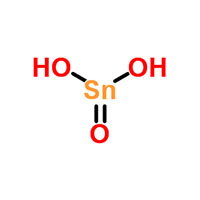Metastannic Acid
Specifications
| Item | Index |
| Appearance | White powder |
| Product granularity | -0.10mm≥98% |
| Product grade | 86%,88 % |
Packing& Storage
| Packing | ||||||||
| Storage | 20℃, 2 years. | |||||||
| Shipping | Room temperature in China; may vary elsewhere | |||||||
General Information
1.1 Chemical & Physical Properties
| Common Names | Metastannic Acid | Tin hydroxide oxide | ||||||
| Structure |  |
||||||
| CAS No. | 13472-47-4 | Boiling Point (℃) | N/A | ||||
| Molecular Weight | 168.724 | Melting Point (℃) | N/A | ||||
| Appearance | White amorphous powder | Vapor Specific Gravity | N/A | ||||
| HS Code | 2825909000 | Flash Point (℃) | N/A | ||||
| Solubility | Insoluble in water, insoluble acid and lye, and alkali co-melting can obtain metastannate, heating significantly water loss. | Autoignition Temperature (℃) | N/A | ||||
1.2 Safety Information
| Safety Phrases | – | |
| RIDADR | – | |
| WGK Germany | – | |
| Packaging Group | – | |
| Hazard Class | – | |
1.3 Synthetic Route
Metastin acid can be prepared by reacting fine tin with concentrated nitric acid, separating and drying by filtration.
Applications of Metastannic Acid
Metastannic acid is mainly used as a flame retardant for chemical fibers and textiles, plastic products, paint coatings, and epoxy resin sealing materials; as a colorant for ceramic products; as an additive for printing inks; as a mordant in the textile industry.
